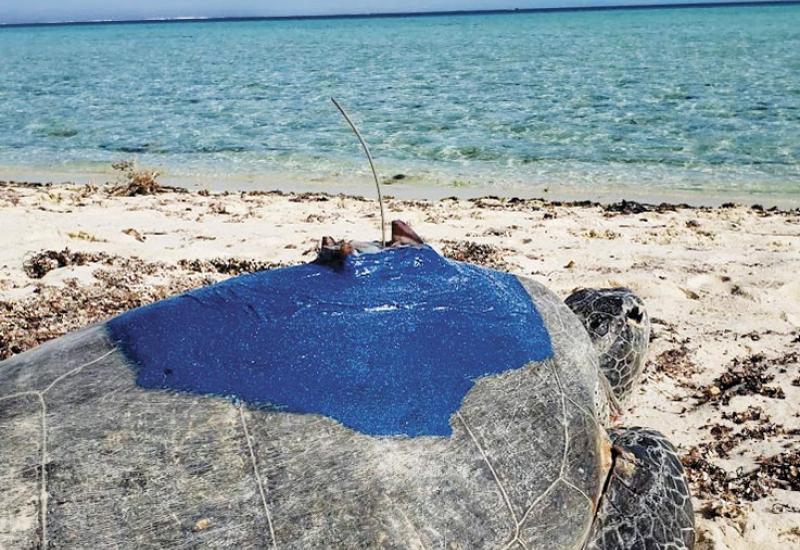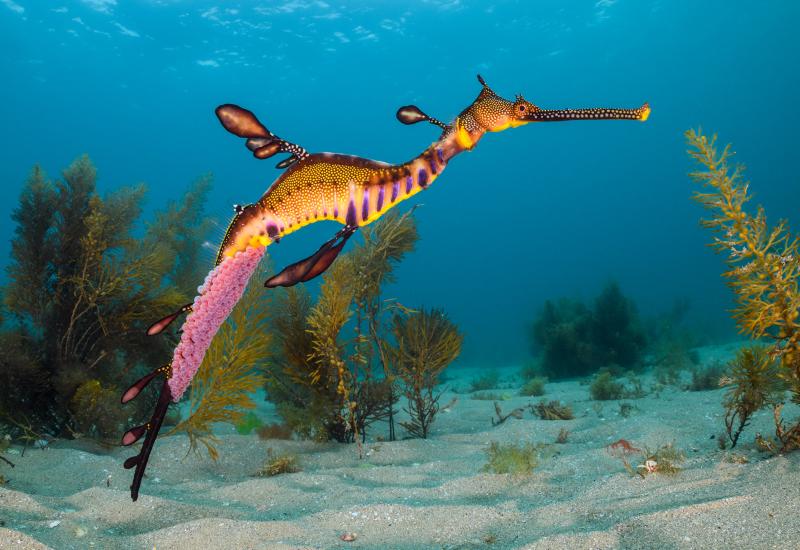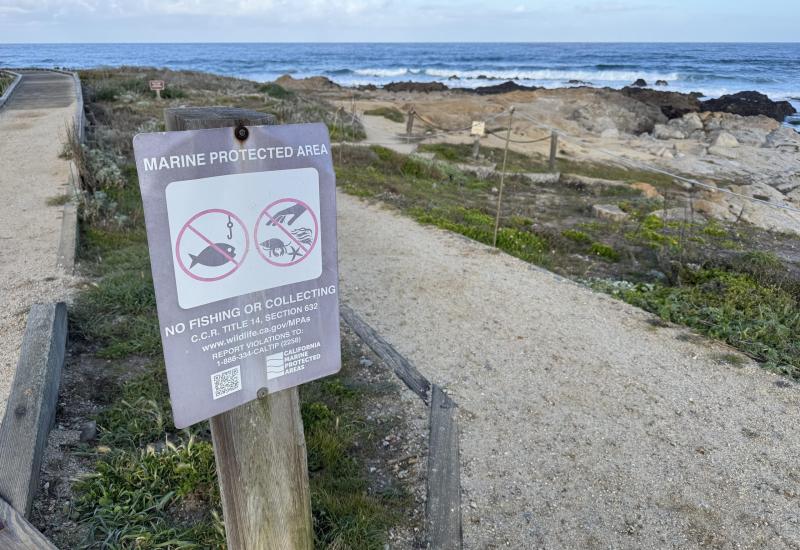The Vibrant Visayas: Scuba Diving in the Philippines
There are two things you need to know about the Philippines: First, you’ll want to see it all; second, you won’t be able to. With 7,107 islands scattered across the western Pacific Ocean, the Philippines offers an ample buffet of undersea beauty that’s as lavish as a sumptuous wedding feast. So it’s best to graze, sampling as you go.

Greg LecoeurMesmerizing sardine shoal at Moalboal
Become mesmerized as you watch the shoal of sardines at Moalboal shimmer through the water.
On this, my first trip to this bustling country of around 100 million inhabitants, I’ve prepared three well-rounded courses in the Visayas, a group of islands south of Manila: First up are the thresher sharks of Malapascua Island, followed by the tiny (but no less impressive) sardines at Moalboal. Dessert is muck diving in Dauin — I’ve brought a list of the weird and wacky creatures I’m ready to cross off my must-see list. After a night spent in Manila at the luxurious Fairmont Makati, it’s back to the airport, en route to Cebu and Malapascua. I’m ready to dig in.
Sitting about 4 miles off the northernmost tip of Cebu, tiny Malapascua Island, only about 2-miles-by-1-mile and with a population of around 8,000, seems almost entirely devoted to diving with them. My ferry from the mainland, a modified outrigger canoe, deposits me on the white sand directly in front of Evolution Resort, where I’ll spend the next three days happily seeking the elusive sharks. For now, I’m seeking dinner and a cold drink, both readily available at the resort’s Irish bar, the Craic House — pronounced “crack” — where all the Filipina waitresses wear shirts that say “Craic Dealer.” Arriving one day after St. Patrick’s Day, I’m told that I missed quite the party: a reggae band, at an Irish bar, in the Philippines. That’s what I call fusion. Despite the strong lure of a good bar and the chatty company of a few locals and divemasters, I call it an early night — the wake-up call for thresher shark dives comes at 5 a.m.

Greg LecoeurDrift diving at Apo Island, Philippines
Drift diving is popular at Apo Island as you get a chance to swim over a variety of rocks and hard coral.
The next morning I awake before my alarm goes off, my anticipation is so great. Malapascua is one of the only (if not the only) places in the world to reliably encounter threshers, as they rise from the deep in the dawn hours to three cleaning stations on Monad Shoal, about a 30-minute boat ride offshore. During the briefing, divemaster Romel Mantos — Jo to us — helpfully suggests: “Don’t chase the sharks.” We depart just as the sun’s first light breaks the horizon, also on board a modified outrigger-canoe-cumdive boat. Divers on board hail from Sweden, Denmark, Colombia, Canada — such is the draw of the threshers. There are at least four other boats at the shoal when we arrive, but when we splash in near the first cleaning station and begin our descent to around 60 feet, we don’t see any other divers — we do, however, see a shark almost immediately. It’s as otherworldly as the images I’ve seen, with a gleaming silver body, luminous black eyes, a partially open mouth, and that famous tail that swooshes through the water like ascythe. Soon there are two, making a figure eight as they sinuously circle each other. They come within 10 feet, clearly keeping an eye on us as they receive their spa treatments. We see at least three more sharks on that first dive, and we do encounter the other divers, all kneeling behind a rope tied to two cement blocks at one of the stations. Although the gallery seating is meant to give the sharks some space, it doesn’t do the same for divers; Jo does a great job of bypassing the crowds and keeping our small group separate. When we surface, we can hardly contain our excitement. It’s not even 7 a.m. and it already feels like a stellar day underwater, even though we’ve got plenty more to come. After splashing in with the threshers, we visit Gato Island, just west of Malapascua, where there’s a gorgeous swim-through cavern, a healthy population of reef fish, seahorses, nudibranchs ranging from tiny to enormous (for nudibranchs, of course), and on our second dive, a school of squid. The next day we dive the Bugtong (Bogtong) Bato pinnacle near Malapascua, which is covered in waving tufts of soft corals in pink, yellow and orange, and I spot the biggest, blackest frogfish I’ve ever seen.
Related Reading: Where to Dive for the Most Value

Greg LecoeurCrinoids at Apo Island
Crinoids are the perfect hiding place for small sea critters such as the ghost pipefish.
On my final day here, I’m taking a few minutes to chat with one half of the duo that owns Evolution, British expat Matt Reed (business partner David Joyce is Irish, hence the Irish bar). The resort opened in 2010, and Reed says it’s the diversity of diving that drew them here. “It’s not just the sharks; divingwise it has a bit of everything,” he says. “And we’ve also got a white-sand beach.” And he’s right — I’ve already seen everything from the tiniest nudi to the mysterious thresher shark. And this is only the appetizer in my Philippines buffet.
About two-thirds of the way down the west coast of Cebu is Moalboal, known for something quite the opposite of Malapascua’s threshers: a gigantic, shimmering shoal of sardines that hugs the shore. I check into charming Turtle Bay Dive Resort, sitting at the elbow of the small peninsula, which juts out from the mainland like a bent forearm. I take in the view of Badian Bay and check in at the dive shop before meeting owners Chris White, a British expat, and his Filipina wife, Fe. Both divers, they’d visited the area with their children for almost 30 years before buying this waterfront parcel of land 10 years ago, home now to the resort. “We really didn’t have a plan,” says Chris. “Or maybe she had a plan that she didn’t tell me about. Later she persuaded me to turn it into a dive resort.”

Greg LecoeurSea turtles at Apo Island
Sea turtles frolic through open waters around Apo Island and are curious enough to get close to cameras.
You wouldn’t think that something so small could be so magnificent, but it is, this enormous cloud of tiny fish that covers the shoreline like a shroud. Divemaster Robinson Pardo (Robin) and I back-roll into the water — but before we even do, I can see them gleaming 20 feet or so below the surface. The school stretches in both directions as far as I can see. We drift lazily left, following a gentle but insistent current, gliding along through school after school, each one parting before us like the curtain at a Broadway show. The tiny fish are mesmerizing — and so thick that I don’t see divers coming toward us until they’re almost upon us, and the curtain parts to allow their passage. Our dive lasts nearly an hour before we run out of sardines, but not before we also spot a few big sea snakes and a juvenile harlequin sweetlips, wriggling its way under some coral as we pass by. “They’re always dancing,” says Robin.
Just offshore from Moalboal is Pescador Island, site of our dives the next day. Fe tells me that, although Pescador had been protected for many years, a few years ago there were illegal fishing nets at the island ensnaring the sardines that have since migrated to the shore. Local dive-shop owners banded together to collect video and photos of the damage that was being done to the island’s fields of hard coral, ensuring the safety of both the islands and sardines. Pescador now plays host only to dive boats and the small outriggers of local fishermen who line-fish.
Related Reading: How To Pick a Scuba Diving Instructor

Greg LecoeurClown frogfish at Dauin
A young clown frogfish poses for the camera. Interested in seeing them? Baby frogfish seasons usually last from March through June.
We motor out early the next morning for two dives here, where the coral garden starts shallow and slopes down to a wall that drops into the blue. We descend in to crystalline waters and a gentle drift around the southwest side of the island, where the hard coral looks healthy, teeming with anthias and other small reef fish. Damselfish flit in and out of a staghorn forest, and a territorial clownfish gives me a stern look when I come too near his anemone. I spot a white frogfish — or rather, Robin spots a white frogfish and points it out to me — as well as lionfish, gigantic triggerfish, midnight snapper and schools of Moorish idols. Our next drift takes us along the other side of the island, where we see two turtles, gigantic barrel sponges, and sea fans dotted with a rainbow of crinoids. On my last dive at Moalboal, we visit the Saavedra Fish Sanctuary near the peninsula’s northern tip. The coral here also looks spectacular, and we drift over it for more than an hour in only around 25 feet of water. There are diagonal-banded sweetlips, lots of ill-tempered clownfish, and a cadre of jawfish digging an immense hole together — for what, I’m not sure. They seem nonplussed by my presence and continue methodically spitting mouthfuls of sand at me while I goggle at their efforts.
The only drawback of my “sampler platter” approach to the Philippines is that my stay at each place comes to a close far too soon. After only three nights at Turtle Bay, it’s time to move on. Next up: muck-diving madness.

Greg LecoeurGhost pipefish at Apo Island
Ghost pipefish are masters of disguise and often blend in with the criniods at Apo Island.
I'm island-hopping from Cebu over to Negros for my final stop at Atmosphere Resort & Spa in Dauin. The bright-white thatched-roof cabanas and two infinity pools overlooking the sea are lovely. At the dive shop there’s a chalkboard-size dry-erase board on the wall, and it’s like a daily menu for all the resort’s boats, which ones are going where and when: a buffet within the grander feast I’ve been sampling. One must only write her name on the lines below whatever dives appeal: a visit to the house reef’s resident pygmy seahorse or a dusk mandarinfish dive? Yes, please. A day trip to nearby marine sanctuary Apo Island? Yes, please.

Greg LecoeurMantis shrimp at Dauin
Watch for mantis shrimp and other small sea life in muck-diving mecca Dauin.
I’ve arrived early enough to squeeze in two dives. They say you never forget your first muck dive — well, maybe they don’t, but they should. Mine is at a site called the Cars, about 10 minutes north of the resort by boat. Divemaster Je-An Binarao is my personal tour guide as we drop in along a nondescript (or so I think) brown, sandy slope, interrupted only by small stands of coral or rocks. Almost immediately Je-An begins to dazzle me, first by pointing out an ornate ghost pipefish. Before I know it, we’re hugging the bottom at around 85 feet, me trying desperately not to stir anything up as we creep ever so slowly along the sand. I check one must-see and then another off my hit list as Je-An waves his magical muck stick: painted frogfish, Randall’s frogfish, baby frogfish, harlequin shrimp, flamboyant cuttlefish, stargazer snake eels, juvenile ornate ghost pipefish, an estuary seahorse, rough-snouted ghost pipefish. I’m giddy with glee before the dive is even half through.

Greg LecoeurFrogfish haven at Moalboal
The group of islands known as the Visayas have beautiful waters that are perfect for a variety of sea life including this frogfish in Moalboal.
Our second dive of the day is on Atmosphere’s house reef, the same brown sand dappled with little patches of coral outcroppings. We’re doing a reverse mandarinfish dive, wherein our dive climaxes (ahem) by spying on the lovers at dusk as they mate, after we’ve already cruised the reef for around 45 minutes. We spend almost 90 minutes in the water, the last 45 hovering near a pair of likely candidates. At first I’m charmed by their coy courtship, but as my fingers prune and my lips begin to chatter, I wonder if perhaps Mr. Mandarinfish should have asked his lady friend to dinner first. Finally their love is requited, as the male sidles up gently to the female and they touch sides, rising slowly together out of the coral until — poof! — it’s done.

Greg LecoeurMating mandarinfish
Male mandarinfish court possible mates every evening at dusk. Once the female agrees, they rise out of the coral together to mate.
The next morning my guide, Noel Teves, and I visit the house reef’s resident pygmy seahorse, which lives on a sea fan at around 100 feet. Noel spots the little guy immediately. He hears me proclaim “So cute!” into my regulator, and as we gaze upon the tiny creature, no larger than one-third-of-an-inch tall, the shy animal turns and faces the other way. I follow him to the other side of the fan, wherein he promptly turns back around. I decide to give him a little space and content myself with gazing at him from the side of the fan as a school of barracuda cruises by to say hi.

Greg LecoeurPygmy seahorse in the Visayas, Philippines
The Philippines is the perfect place to go hunting for pygmy seahorses.
I spend my final day in the water at Apo Island, a community-run marine sanctuary just offshore from Atmosphere. The draw here is an amazing hard-coral garden — brain coral, table coral, branching coral — stretching out beneath us, all of it teeming with busy reef fish. We spend the day on the boat, diving three sites: Chapel Point, where we fin out over the garden and drop down over the wall; Katipanan, another sloping, vibrant hard-coral garden; and Largahan, a sandy slope where jets of bubbles rise like those in a glass of champagne out of the volcanic soil below.

Greg LecoeurThe elusive thresher shark
Thresher sharks, named for their scythe-like tail, are a highlight of diving in Malapascua.
On my final night at Atmosphere, I chat with owners Matthew and Gabrielle Holder. Matthew, an architect, designed the resort, and Gaby, a longtime PADI course director, runs the resort’s IDCs. When asked what drew them to Dauin, Matthew echoes Matt Reed from Evolution. “The extent of the macro is exceptional,” he says," but the variety of diving here is outstanding.”
Holder’s comments only confirm what I’ve found to be true at this buffet: From the tiniest pygmy seahorse to the commanding thresher shark, your plate will always be full in the Philippines.
Special thanks to the Philippines Department of Tourism, Philippine Airlines, the Fairmont Makati and Jeepney Tours.










